Managing Chronic Pain in an Age of Addiction
Managing Chronic Pain in an Age of Addiction
Akhtar Purvez, MD
Foreword by John Rowlingson, MD
ROWMAN & LITTLEFIELD
Lanham Boulder New York London
Medicine is a science and an art. A clinician-patient relationship is fundamental to the arrangement that is necessary to offering and receiving medical care. Patients are advised to consult a qualified clinician for any medical needs and advice. This book is meant to be an authoritative account of issues related to chronic pain and addiction. The information provided should not be construed as medical advice and no such relationship is or should be implied. The author and publisher do not take any responsibility for any consequences resulting from utilization of any information presented in this book.
Published by Rowman & Littlefield
An imprint of The Rowman & Littlefield Publishing Group, Inc.
4501 Forbes Boulevard, Suite 200, Lanham, Maryland 20706
www.rowman.com
Unit A, Whitacre Mews, 26-34 Stannary Street, London SE11 4AB
Copyright 2018 by The Rowman & Littlefield Publishing Group, Inc.
All rights reserved. No part of this book may be reproduced in any form or by any electronic or mechanical means, including information storage and retrieval systems, without written permission from the publisher, except by a reviewer who may quote passages in a review.
British Library Cataloguing in Publication Information Available
Library of Congress Cataloging-in-Publication Data
Names: Purvez, Akhtar, author.
Title: Managing chronic pain in an age of addiction / Akhtar Purvez.
Description: Lanham : Rowman & Littlefield, [2018] | Includes bibliographical references and index.
Identifiers: LCCN 2018012528 (print) | LCCN 2018012053 (ebook) | ISBN 9781538109236 (cloth : alk. paper) | ISBN 9781538109243 (Electronic)
Subjects: | MESH: Pain Managementmethods | Chronic Paindrug therapy | Chronic Paincomplications | Analgesics, Opioidadverse effects | Opioid-Related Disordersprevention & control | Behavior, Addictiveprevention & control
Classification: LCC RB127 (ebook) | LCC RB127 (print) | NLM WL 704.6 | DDC 616/.0472dc23
LC record available at https://lccn.loc.gov/2018012528
 TM The paper used in this publication meets the minimum requirements of American National Standard for Information Sciences Permanence of Paper for Printed Library Materials, ANSI/NISO Z39.48-1992.
TM The paper used in this publication meets the minimum requirements of American National Standard for Information Sciences Permanence of Paper for Printed Library Materials, ANSI/NISO Z39.48-1992.
Printed in the United States of America
To my patients and their families for their perseverance, patience and courage.
Foreword
All of us have experienced acute pain from an injury or surgery. The pain provoked a visit to a doctor or a hospital, the diagnosis was made, treatment was provided, and the pain disappeared after a short time. That is hardly the course for patients with chronic pain. Their pain lingers, and it becomes harder to deal with as time passes. Treatments that ease acute pain dont always work for chronic pain, creating friction between the patient and the prescribing doctor, who may not be trained to manage chronic pain. Whats worse is that the enduring nature of chronic pain results in changes in the patients attitude about ever getting healthy again, dramatic behaviors that are fueled by the patients frustration at the persistence of pain in spite of treatment, and major lifestyle disruptions, such as limiting the patients ability to go to work. While these events play on the patients and the loved ones supporting them, anxiety, depression, and other psychological effects become more prevalent and interfere with their day-to-day existence. As if these consequences arent enough trouble, chronic pain actually leads to changes in the function of the patients nervous system, almost assuring that the pain will persist.
One of the key elements of chronic pain management is the evaluation of the patient to establish whats actually causing the pain. This process must investigate all dimensions of the patients being, including the physical, emotional, social, economic, and spiritual realms. The patient must be fully open with the physician about the history of the pain. The physical examination documents the muscle, joint, and nerve changes related to the original injury, previous surgery, or the limitations induced by the ongoing pain. Laboratory test results can be very disappointing since the studies dont prove the intensity or the presence of pain, nor necessarily support the patients perceived or actual disability. Unfortunately, we do not have a convenient numerical guide, like high blood pressure values or blood sugar levels in diabetes, to measure the impact of chronic pain on the patients life. The use of simple word or number scales to assess chronic pain does not delve far enough into how much the chronic pain disrupts the patients life to provide an adequate picture of the harm.
The doctor must detect how the pain is interfering with the patients ability to function, handle his or her emotions on a daily basis, stay clearheaded in spite of pain medications, and enjoy meaningful activities with family, friends, and coworkers. Just taking the chronic pain away does not solve all of the pain-related issues. Thus, the patient needs both a thorough evaluation and a dynamic pain management plan that targets all of the identified contributors to the pain and prepares the patients to be improved.
Chronic pain is rarely cured, so the patient must adopt the concept of managing it as a disease, like diabetes or asthma. The overall goal of pain treatment is to decrease the intensity and the frequency of the pain so that the patients quality of life and ability to function can be enriched. The good news is that most patients will see these benefits from the treatment programthe coordinated use of a number of different modalities to minimize the likelihood of treatment side effects but that, when used together, create a sustained decrease in pain. The use of medications alone will not be successful. They have many side effects including dependence and addiction. Patients enjoy freedom from pill taking when they embrace physical therapy, yoga, meditation, and other treatments described in this book that address more of the disease elements of their chronic pain.
This book is a breath of fresh air among the innumerable textbooks dealing with pain management. The text is written in the style of a direct, honest conversation with the patient, resulting in the patients understanding of the chronic pain. It anticipates the patients questions and provides the answers in a straightforward dialogue. It communicates in the language of the average patient to explain why the pain persists and doesnt merely go away. This book is wide ranging in its coverage of essential topics that the author genuinely wants the patient to comprehend. It broadcasts the message that while all pain may not disappear, modern-day treatment helps the patient cope with leftover pain.
This book acknowledges that chronic pain is not only the patients problem. The book will beckon those who have lost their social network and have replaced their independence with reliance on others. It will have a life-changing impact on patients and their caregivers, so that the evils of chronic pain have a lesser hold on their lives. The books content will impart valuable knowledge so that patients and their doctors will not make decisions about pain management in the unhealthy mind-set of desperation. The book highlights that there is so much more to be done for pain management than just providing medications and that the patient
Next page

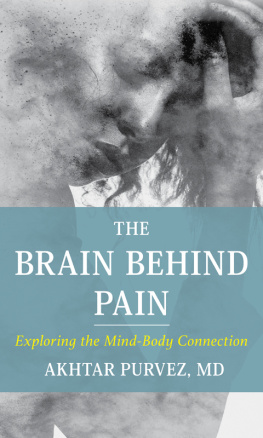
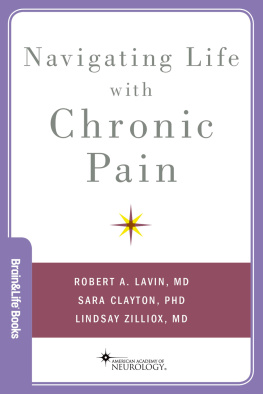
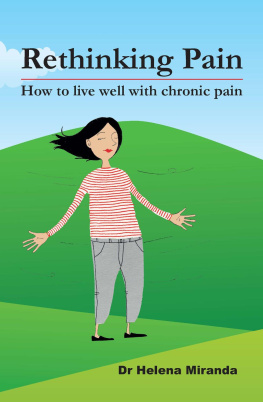

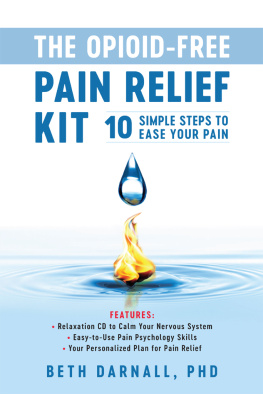
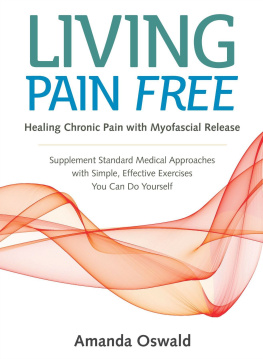
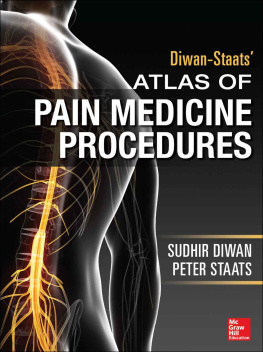
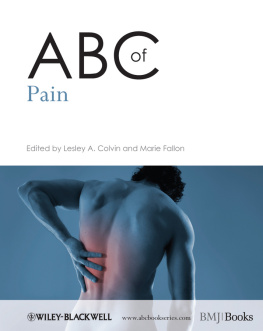
 TM The paper used in this publication meets the minimum requirements of American National Standard for Information Sciences Permanence of Paper for Printed Library Materials, ANSI/NISO Z39.48-1992.
TM The paper used in this publication meets the minimum requirements of American National Standard for Information Sciences Permanence of Paper for Printed Library Materials, ANSI/NISO Z39.48-1992.